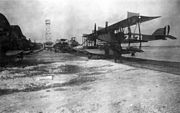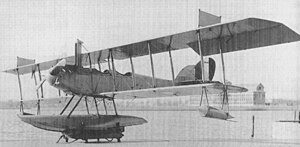| Model N | |
|---|---|
| Curtiss N-9H | |
| Role | floatplane |
| Manufacturer | Curtiss, Burgess Company |
| Designer | Glenn Curtiss |
| First flight | 1916 |
| Primary user | United States Navy |
| Number built | 560 |
The Curtiss N-9 was a floatplane variant of the Curtiss JN-4 "Jenny" military trainer used during World War I by the United States Navy.
Design and development[]
As a seaplane, the N-9 was equipped with a single central pontoon mounted under the fuselage. A small float was fitted under each wingtip. With the additional weight of the pontoon, a number of structural and aerodynamic changes were required, the design of which made use of wind tunnel data developed at the Massachusetts Institute of Technology, meaning the N-9 was the first American naval aircraft to incorporate wind tunnel data directly into its design. The wingspan was stretched an additional 10 feet (3 meters), the fuselage was lengthened, the tail surfaces were enlarged, and stabilizing fins were added to the top of the top wing. The N-9 was initially powered by a 100 hp (75 kW) Curtiss OXX-6 engine.

Curtiss was awarded an initial contract for 30 aircraft in August 1916, and an additional 14 were ordered by the United States Army, which maintained a small seaplane operation. It quickly became apparent that the aircraft was underpowered, so Curtiss replaced the engine with a 150 hp (112 kW) Hispano-Suiza, manufactured in the United States under license by Wright-Martin's Simplex division (later Wright Aeronautical). The aircraft was redesignated N-9H.
A total of 560 N-9s were built during World War I, most of which were "H" models. Only 100 were actually built by Curtiss. Most were built under license by the Burgess Company of Marblehead, Massachusetts. Fifty others were assembled after the war, from spare components and engines by the U.S. Navy at Naval Air Station Pensacola in Florida.
Operational history[]
Although the consensus in early 1917 among aviators and even the N-9's manufacturer was that the N-9 could not be looped, the pioneering early United States Marine Corps aviator Francis Thomas Evans, Sr., believed it was possible. On 13 February 1917, he flew an N-9 over the Gulf of Mexico off Pensacola, Florida, and began attempts to loop it. He succeeded on his fourth try, becoming the first person ever to loop a seaplane. Lacking witnesses, he flew over Naval Air Station Pensacola and repeated the feat. In 1936, he received the Distinguished Flying Cross for this achievement.[1] More important, however, were the stall and spin recovery techniques he discovered while flying the N-9 that day. During his first three loop attempts, the N-9 stalled before he reached the apex of the loop and fell into a spin. He found that by releasing back-pressure on the stick and aggressively applying opposite rudder to the direction of the spin he could change the spin into a normal dive and recover, something previously thought impossible in an N-9. His stall and spin recovery techniques remain in use to this day by aviators around the world.[1]

Preserved Curtiss N-9H exhibited at the National Museum of Naval Aviation at Pensacola, Florida in 1975.
Over 2,500 U.S. Navy pilots received their seaplane training in N-9s. Besides this primary role, though, the aircraft was also used to help develop shipborne aircraft operations during World War I, especially the development of ship-mounted launch catapults. In 1917, several N-9s were provided to the Sperry Gyroscope Company for conversion to the Hewitt-Sperry Automatic Airplane configuration, flight testing the new autopilot components intended to be used in pilotless "aerial torpedoes". The U.S. Navy retired the N-9s in 1927 as more modern trainers became available.
Survivors[]
Only one example of the type has survived, and is now a part of the National Air and Space Museum collection. Originally on display at the Museum of Science and Industry in Chicago, Illinois, it was later transferred back to the U.S. Navy pending transport to the National Air and Space Museum. The Naval Air Engineering Laboratory in Philadelphia, Pennsylvania, fully restored it in 1966.
Variants[]

A Curtiss N-9 at Naval Air Station Pensacola
- Model N
- 1914 two-seat trainer powered by 100 hp (75 kW) Curtiss OXX engine, similar to Model J but with different aerofoil section. One built for US Army. Later rebuilt as Model O with side-by side seating.[2]
- Model N-8
- Production version of N for US Army, powered by 90 hp (67 kW) Curtiss OX-2 engine. Equivalent to JN-3. 4 built 1915.[3]
- Model N-9
- Two-seat single-engined trainer floatplane.
- Model N-9N
- Powered by a 150 hp (112 kW) Wright A piston engine.
- Model N-9C
- The original N-9 floatplane with the 100 hp (75 kW) engine, later became known as the N-9C.
Operators[]
Specifications (N-9H)[]
Data from Curtiss Aircraft 1907–1947[4]
General characteristics
- Crew: 2
- Length: 30 ft 10 in (9.39 m)
- Wingspan: 53 ft 4 in (16.25 m)
- Height: 10 ft 11 in (3.32 m)
- Wing area: 496 ft² (46.07 m²)
- Airfoil: RAF 6[5]
- Empty weight: 2,140 lb (971 kg)
- Loaded weight: 2,750 lb (1,247 kg)
- Powerplant: 1 × Wright-Hispano A water-cooled V8 engine, 150 hp (112 kW)
Performance
- Maximum speed: 78 mph (68 knots, 126 km/h)
- Service ceiling: 6,600 ft (2,012 m)
- Climb to 3,240 ft (987 m): 10 min
References[]
- Notes
- Bibliography
- Bowers, Peter M. Curtiss Aircraft 1907–1947. London: Putnam, 1979. ISBN 0-370-10029-8.
- National Air and Space Museum information
External links[]
| Wikimedia Commons has media related to Category:Curtiss Model N. |
The original article can be found at Curtiss Model N and the edit history here.
